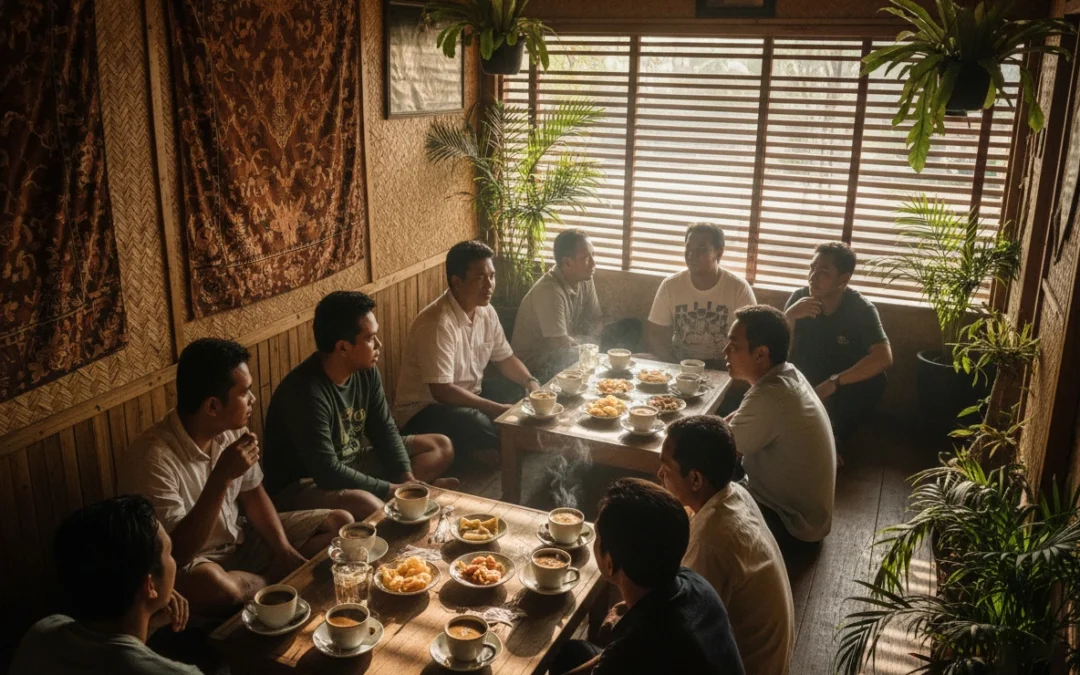Uncover what makes Indonesian coffee famous—from its volcanic origins and ancient traditions to its global reputation as one of the most distinctive coffees on Earth.
Why is Indonesian coffee famous? The answer lies in its perfect blend of geography, heritage, and craftsmanship. With fertile volcanic soil, diverse islands, and centuries of cultivation, Indonesia has shaped coffees unlike any other. Each bean tells a story—from Sumatra’s earthy depths to Bali’s floral brightness. Let’s explore why Indonesian coffee continues to fascinate the world.
The Volcanic Landscape That Shapes Unique Coffee Flavors
Indonesia’s reputation for extraordinary coffee begins with its geography. The country spans thousands of islands across the Pacific “Ring of Fire,” creating one of the most fertile coffee-producing regions on Earth. Volcanic soil, high altitudes, and tropical rainfall combine to nurture coffee trees that yield deep, complex flavors.
According to Wikipedia, coffee was first planted in Indonesia during the 17th century, and the volcanic islands of Sumatra, Java, and Sulawesi remain central to its production today. The mineral-rich soil adds distinctive earthy, spicy, and chocolatey tones that make Indonesian coffee famous among connoisseurs.
Each island offers something special. Sumatra is known for its bold, low-acid beans; Java delivers a smooth, nutty balance; and Sulawesi offers rich, aromatic depth. These regional differences stem not just from soil but also from altitude and microclimate.
High-elevation plantations between 1,000 and 1,800 meters allow slow cherry maturation, intensifying sweetness and aroma. The result is coffee with a strong body and smooth finish—ideal for espresso and specialty blends.
Indonesia’s natural advantages make it one of the few regions capable of producing a full spectrum of flavor profiles, from dark and earthy to light and fruity. The landscape quite literally grows the fame of Indonesian coffee.
The Historical Roots That Spread Indonesian Coffee Worldwide
Why is Indonesian coffee famous? Its legacy stretches back over 300 years. Indonesia was among the first countries outside Africa to cultivate coffee, introduced by Dutch colonists in the 1690s. The Dutch East India Company began large-scale production on Java, and by the 18th century, “Java coffee” became a global export brand.
The island’s beans soon gained fame for their balance and quality, and the term “Java” became a synonym for coffee itself. Historical trade routes spread Indonesian beans across Europe, fueling early coffeehouse culture. The Mocha-Java blend—mixing Yemen’s Mocha beans with Javanese Arabica—became one of the world’s earliest and most enduring coffee combinations.
Even after the devastating coffee rust outbreak in the 19th century, Indonesia adapted by introducing Robusta varieties alongside traditional Arabica. This resilience helped sustain its coffee industry and global reputation.
Today, Indonesia ranks among the world’s top five coffee producers. Its exports reach everywhere from Italy’s espresso roasters to Japan’s specialty cafés. The historical connection between Indonesia and coffee remains unbroken—an enduring testament to both nature and culture.
The story of Indonesian coffee is not just about beans; it’s about perseverance, trade, and identity. Its centuries-long journey from colonial plantations to artisan roasteries makes every cup a sip of history.
Traditional Processing Methods That Define Indonesian Coffee
One of the strongest answers to why Indonesian coffee is famous lies in its processing methods. Indonesia is renowned for its distinctive wet-hulling process, locally known as giling basah.
Unlike the washed or dry methods common elsewhere, wet-hulling involves removing the parchment layer while the beans still contain moisture. This creates a bold, low-acid profile with complex, earthy flavors that are instantly recognizable. According to Coffee Production in Indonesia, this process is a defining feature of Indonesian coffee identity.
Sumatra’s Mandheling beans owe their deep, spicy aroma to this method, while Sulawesi’s Toraja beans exhibit rich chocolate notes and smooth texture. Wet-hulling is also practical—it suits Indonesia’s humid climate by reducing drying time while preserving the beans’ inner character.
Other islands take different approaches. Bali’s Kintamani region uses the washed process, resulting in bright, citrusy notes, while Papua’s Wamena coffees—grown in pristine highlands—are often fully washed for cleaner, floral tones.
These regional differences make Indonesia a microcosm of global coffee diversity. The artistry of its farmers—balancing tradition with adaptation—has made Indonesian beans sought-after staples in specialty markets worldwide.
Cultural Traditions That Keep Coffee Central to Daily Life
Indonesia’s fame also comes from the way coffee is woven into daily life. Coffee isn’t merely consumed; it’s celebrated. Every island has unique customs that showcase how coffee connects people and culture.
In Java, locals enjoy kopi tubruk—coarsely ground coffee brewed directly with boiling water and sugar. This unfiltered drink is strong, sweet, and symbolic of hospitality. In Aceh, especially the Gayo Highlands, coffee ceremonies are integral to social gatherings, representing respect and friendship.
In Bali, coffee blends into spiritual life, often used in offerings during religious rituals. In urban areas like Jakarta and Bandung, modern cafés blend tradition with innovation, creating a thriving specialty coffee scene that supports both local farmers and global standards.
According to Indonesia’s coffee culture, coffee shops are now vital parts of the community and identity. Baristas from Indonesia frequently compete internationally, winning recognition for creative brewing and latte art.
This cultural integration sustains the fame of Indonesian coffee. It isn’t just exported; it’s lived. Each cup represents connection—to land, heritage, and one another.
Global Reputation and Sustainable Future for Indonesian Coffee
The modern world’s fascination with sustainability has given Indonesian coffee renewed recognition. Indonesia’s smallholder farmers—who produce over 90% of its coffee—are now part of global initiatives promoting organic cultivation and fair trade.
Organizations like the International Coffee Organization (ICO) and Fairtrade International collaborate with Indonesian cooperatives to improve quality control, income fairness, and environmental conservation. Many regions, like Bali Kintamani and Gayo Aceh, now hold organic and Geographical Indication (GI) certifications.
These efforts ensure that the same traditional methods that made Indonesian coffee famous also sustain communities and ecosystems. With rising global demand for traceable and ethically produced coffee, Indonesia stands out for its balance between authenticity and modern responsibility.
From global brands to boutique roasters, Indonesian beans are prized for their variety—earthy, spicy, fruity, or floral. They represent a nation of contrasts and creativity. As climate change challenges global agriculture, Indonesia’s diversified coffee landscape gives it resilience and hope for the future.
The fame of Indonesian coffee isn’t just in the past—it’s being reinvented for the next generation.

